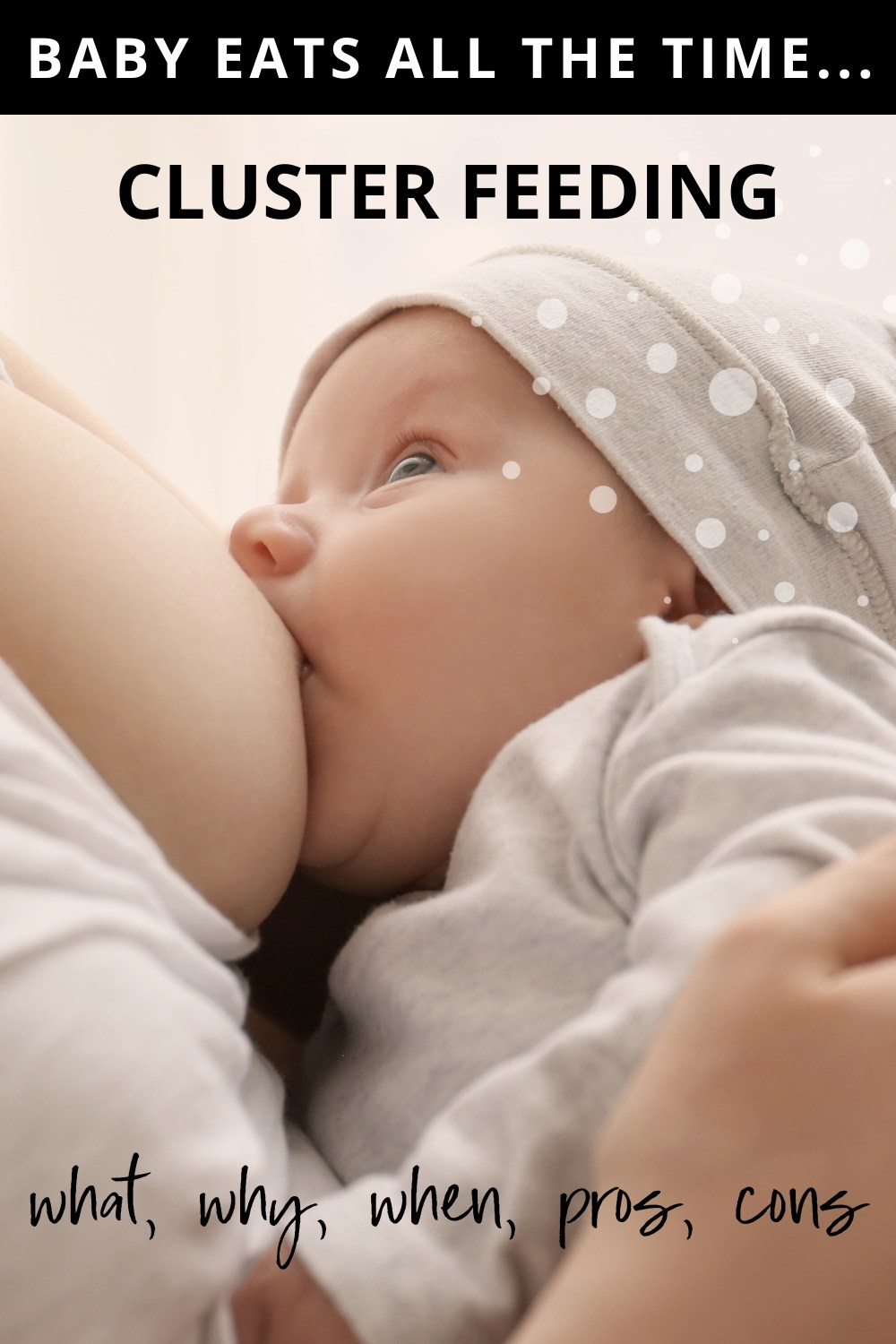Once your baby is born, the exciting process of getting to know each other starts. Sometimes, or even in most cases, that process will be filled with frequent changes in the routine, especially in the early months.
One sudden change in your baby’s usual eating behavior that you may encounter in the early days is cluster feeding – when your baby wants to eat all the time. This can be quite exhausting and make you start wondering if something is wrong. It usually isn’t. Let’s take a deep look at what cluster feeding is, why and when it happens, and what the benefits and challenges are.

What is cluster feeding?
Cluster feeding is when your baby wants to feed more frequently than usual over a period of time. It may seem like your baby wants to feed almost non-stop. During these phases, your baby will eat in clusters for a period of time, usually for several hours.
Although cluster feeding is more common in the late afternoon or evening, your baby may want to nurse more often during the day as well.
The feeding sessions may be shorter than usual, and the baby may have short rests or naps in between the feeding sessions.
You may also notice that your baby is fussier or cries more. They may nurse for a few minutes, then come off your breast, fuss or cry, then nurse a bit more, pull off, fuss, and the cycle repeats.
Don’t worry; cluster feeding is common and completely normal. Although it may be frustrating, and you may start to worry if your child is getting what they need, their desire to feed so frequently at certain points doesn’t mean that your milk supply is low or something is wrong. If your baby seems otherwise content and healthy, is producing enough wet and dirty nappies, and is gaining weight, everything will be okay, and this will soon pass.
Why do babies cluster feed?
It is not completely clear why babies cluster feed. Although there are several theories, none of these is scientifically proven.
Sometimes cluster feeding coincides with growth spurts, which may last a day or a few days. It is possible that cluster feeding helps boost your milk supply because more frequent feeding signals your body to produce more milk to support your baby’s growing calorie and nutrition needs.
Because cluster feeding is more common in the evening, some believe this is a way for the babies to fill up before a longer sleep at night. (Maybe you’ve heard about or experienced the fussy evenings…) Sometimes, when a baby cluster feeds in the evening, they have a longer stretch of sleep during the night, but that is not a rule, unfortunately.
Other theories say that your child may be fussier in the evening because they are overtired or overstimulated by the end of the day, and they rely on you and nursing for comfort and soothing.
At what age does cluster feeding usually happen?
Cluster feeding usually happens during the early days of breastfeeding, from newborn and to around 6 months of age. It is very common between three and six weeks of your baby’s life, as this is also when your baby is experiencing growth spurts.
Growth spurts usually happen when your baby is around three weeks, six weeks, three months, and six months old. These are just approximate times, and your baby may not undergo growth spurts at these times exactly, as every baby is different.
How long does cluster feeding last?
Cluster feeding usually happens at certain periods during the first few months of your child’s life. When it happens, one such phase may last for a few days, during which your baby may want to nurse almost back-to-back for several hours a day, with only short rest periods.
At times, it may seem as if a cluster feeding phase lasts for weeks, as growth spurts may happen very close to one another.
So how do you break cluster feeding? Well, there’s no need to!
By the time your baby is 3 to 4 months old, cluster feeding will usually end. However, it may also happen with older babies, especially when they need more comfort.
And how long does a typical cluster feeding session last? In my experience, especially if it occurs in the evening, it can go one for a few hours. This doesn’t mean that your baby eats constantly for several hours, but that they are fussy and want to suck on and off frequently during a few hours.
Cluster feeding in formula-fed babies
Cluster feeding is also possible even when the baby is formula-fed. As we’ve mentioned, babies sometimes want to feed more often when they need soothing and want to be close to you.
It is easier to tell when the baby is feeding for comfort when they are bottle-fed because you can see how much they’ve eaten already.
Look for the signs that your baby has had enough to eat; they may start spilling the milk out of their mouth, turn away or push the bottle away. If the baby overeats, they will usually throw up excess food.
Benefits of cluster feeding
During cluster feeding, your baby will spend even more time on your body, which increases the time of skin-to-skin contact.
Your baby’s increased need for milk during cluster feedings may also boost your milk supply.
Babies often want to nurse more often when they seek comfort, need soothing, or need help to regulate emotionally. Breastfeeding will help in soothing your baby and in answering their emotional needs.
Although not a rule, babies may sleep longer after cluster feeding.
By breastfeeding more often when your baby needs it, you also give them the nourishment they need to grow and develop properly.
Challenges of cluster feeding
When your baby wants to feed so often, especially if accompanied by increased fussiness, it may be physically and emotionally challenging. As a result, you may feel exhausted and frustrated.
Your baby’s increased demand for milk may also make you worry about your milk supply and whether your baby is getting all the necessary nourishment. This may make you feel helpless, anxious, and discouraged.
Your nipples may be more sore, and you may be even more sleep deprived if your baby is waking up more often to nurse.
Because your baby may want back-to-back feedings for several hours, you will have less time to spend with the rest of your family or doing other activities/tasks. This may be pretty challenging if you have other kids.
Find tips on how to cope with cluster feeding here.
Is cluster feeding a sign of low milk supply?
The fact that your baby wants to feed more often doesn’t necessarily mean that your milk supply is low. It also doesn’t mean that you need to supplement with formula.
Milk production usually functions on the supply and demand principle. As your baby grows, the nutritional needs change. When undergoing growth spurts, they need more nourishment and will want to nurse more often. This will signal your body to produce more milk, in other words, to increase the milk supply to meet the demand.
If your baby is gaining weight and is producing enough wet and dirty diapers, you probably shouldn’t worry about your milk supply.
Keep in mind that your baby may also be fussier than usual during these periods, which also shouldn’t be taken as a definitive sign that they aren’t getting enough milk.
If you are still worried you aren’t producing enough milk, talk to a lactation consultant or a pediatrician.
Is cluster feeding a sign of colic, teething, or pain?
Cluster feeding is not a sign that something is wrong with your baby. Your baby may cluster feed for several reasons; one may be soothing when they need extra comfort.
Cluster feeding and infant colic have some similarities as both often occur in the evening, and they seem to appear suddenly. However, when your baby has colic, breastfeeding or formula won’t help them calm down. With cluster feeding, although your baby may be fussier than usual, feeding will help soothe them.
Other colic symptoms include crying that sounds more like screaming for at least three hours a day, at least three days a week, for at least three weeks; body and face tension; and facial discoloring (skin flushing or blushing).
Cluster feeding also isn’t a sign of teething, although some babies may want to nurse more often when they are teething because they find it soothing. On the other hand, some babies will actually want to breastfeed less frequently when they are teething.
When should I seek help?
Although your baby’s need for more frequent feeding or fussiness aren’t necessarily signs that your milk supply is low, if you still worry about it or suspect that may actually be the case, you can always talk to a pediatrician or a lactation consultant and ask for advice.
You should also talk to a pediatrician if your baby:
- Isn’t gaining weight
- Isn’t producing enough wet or dirty diapers
- Isn’t settling even after the feeding
- Seems sick, lethargic, or weak
- Shows signs of jaundice (yellowing of the skin and the whites of the eyes). Breast milk jaundice usually appears in the first or second week of life and can last for several weeks, often up to 8-12 weeks. It usually resolves by itself without having to discontinue breastfeeding.
Takeaway
Cluster feeding is a common and normal occurrence that usually happens in the first several months of your baby’s life. It helps your baby get the extra nourishment they need as they grow and go through growth spurts. It also helps soothe and relax your baby when they need more comfort.
As it may be physically and emotionally draining to feed the baby so frequently for several hours a day, possibly for several days, it is important to take care of yourself and get the support you need.
Read Next
- How to cope with cluster feeding
- How to Stop Leaking Breast Milk as a Breastfeeding Mom
- 1-Month-Old Baby Wants To Eat All The Time
Research References
- Cluster feeding | Australian Breastfeeding Association
- Breast Milk Jaundices – NCBI Bookshelf
- Breastfeeding – Cluster feeding

Paula Dennholt founded Easy Baby Life in 2006 and has been a passionate parenting and pregnancy writer since then. Her parenting approach and writing are based on studies in cognitive-behavioral models and therapy for children and her experience as a mother and stepmother. Life as a parent has convinced her of how crucial it is to put relationships before rules. She strongly believes in positive parenting and a science-based approach.
Paula cooperates with a team of pediatricians who assist in reviewing and writing articles.






